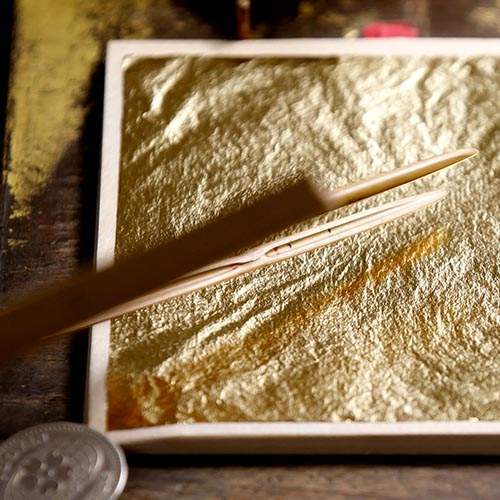Elegance.
It's Glitter of Gold.
It is a perfect item that can be arranged beautifully and gorgeously by sprinkling it on food, sweets, and drinks.
It is a popular item that is also appreciated as a gift for loved ones.

It is a perfect item that can be arranged beautifully and gorgeously by sprinkling it on food, sweets, and drinks.
It is a popular item that is also appreciated as a gift for loved ones.

The history of gold leaf has been passed down as a traditional culture in Kanazawa, Japan. Gold leaf craftsmen in Kanazawa have created new value for gold leaf in their changing lives while preserving traditional handicrafts. There is the feeling and passion of such craftsmen in “Kin no Kagayaki”.
Variety of Ways to Use









The city of Kanazawa accounts for more than 98% of the domestic production of gold leaf and is called to be the “Golden City”. There is a 400-year history of gold leaf in this neighborhood, and we believe that it is our great mission to preserve this tradition. But only keeping tradition is not enough. We believe that it is the true “preservation of tradition” that people realize the value of gold leaf in modern life and recognize it as necessary for their lives. Keep tradition and incorporate it into people’s lives. That is our feeling for gold leaf.

It has not been clarified exactly when the first gold leaf was made in Japan. In ancient times, accessories from the Kofun period with gold leaves have been excavated. Gold has been used in temple architecture and Buddhist sculpture as a symbol of eternity and immutability since ancient times. With the permeation of Japanese Buddhist culture that develops in Heian, Muromachi, and Azuchi-Momoyama, the foil-making technology introduced in China eventually became established as a unique item in Japan, and it can be said that it has developed to this day. It is uncertain when the production of gold leaf began in Kanazawa, but Toshiie Maeda, the founder of the domain of Kaga, was the envoy of Ming from the role of Toyotomi Hideyoshi’s Chosun in 1593. It is said that he was given the role of welcoming the group and sent a book ordering the production of gold leaf and silver leaf in Kaga and Noto, the territory, in order to decorate the spear of the warriors.
Toyotomi Hideyoshi, known for his love of gold, preferred to use gold leaf for castle towers and furnishings. A large amount of gold leaf tiles have been excavated from the vicinity of Toshiie Maeda, the founder of the Kaga domain, Jurakudai, where the daimyo and others had their residences, and Fushimi Castle. As a symbol of power, it is presumed that various daimyo used gold leaf in various places such as roof tiles and interior decoration.
In the era of Ieyasu Tokugawa, the production of gold leaf was strictly controlled as a policy to solidify the economic system of the Shogunate. Due to the “Foil Stamping Ban”, it was strictly prohibited in land other than Edo and Kyoto. However, the sheet metal work was secretly continued, centered on the Kaga domain’s craftsmanship. Under such circumstances, the Kaga domain focused on the development of traditional crafts such as Kutani ware, Wajima lacquerware, Yamanaka lacquerware, and Kaga lacquer work, and laid the foundation for today’s craft kingdom Ishikawa.


With the acquisition of a license to set up the foil for the Kaga domain in 1864, Kanazawa’s gold leaf has made remarkable progress in both quality and quantity. Due to the abolition of the foil seat and the collapse of the Edo Shogunate due to the Meiji Restoration, the control of the gold leaf industry was cut off, and the superiority of Kanazawa foil increased at once. Due to the war damage of World War I, Germany, which was the largest foil producing area in Europe until then, was devastated, and the foil industry in Kanazawa developed dramatically. Kanazawa foil has developed to this day by deeply rooting in faith such as Buddhist altars, Buddhist altars and Mizuhiki.
Kanazawa foil, which was a material, has been recognized as a Kanazawa foil craft in modern times and has established itself as a representative traditional craft of the craft kingdom Kanazawa. Gold leaf has come to be used not only in crafts but also in foods and cosmetics, and recently, there is an increasing demand as one of the materials that expands the new expressive power of architecture and interiors. Kanazawa foil is a general term for not only gold leaf but also silver foil, tin foil, brass foil and other foils. Not only expressing the color of the metal itself, but also subtly changing the composition, applying special processing, and changing the pasting method, the expressive power expands infinitely. Kanazawa foil will continue to make a new history.


![]() California Delivered California Proposition 65:
California Delivered California Proposition 65:
This product contains chemicals known to the State of California to cause cancer and birth defects or other reproductive harm.
For more information: https://www.p65warnings.ca.gov/